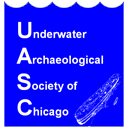Underwater Archaeological Society Of Chicago
Meeting Minutes
July 2016
Secretary Carol Sommers called the meeting to order. Other officers were not present. About 19 members were in attendance.
ISCCD – The Jim Haigh Memorial dive of July 17-18 had a good turnout with an excellent band and food. New cement pieces have been sunk in the quarry.
The Chicago Maritime Museum – It is open from 10 to 4, Tuesdays through Saturday and Jim Jarecki said that attendance has improved, with an average of ten visitors coming each day.
Surveys – There were no survey reports.
Dive Adventures – Tom went to Buddy Dive in Bonaire and became recertified since his 1977 Padi Open Water which had certified him to 140 feet now only is good to sixty feet. He now has his Advanced Certification and got to dive the Helma Hooker.
Member presentation – Carol Sommers showed a five-minute video of the Great White Sharks at Dyer Island near Capetown, South Africa. It’s the largest concentration in the world and she saw six of them while in the safety of a steel cage.
Feature presentation – Tom Ewert spoke about his 2005 dive in a Russian submersible to the German battleship the Bismark. This was the first commercial tour. There are only five submersibles which can descend to this 15,500-foot depth. The US, France and Japan each have one and Russia has two. They are all used for peaceful purposes although they are capable of cutting deep communications lines. The submersibles and the 500-foot long mother ship were built in Finland. The ship is the largest ocean exploration ship in the world and contains a dozen laboratories. The seven-foot diameter submersible holds three passengers who view the sea through a porthole while lying down on a bed. Passengers get to sit in it beforehand to get used to the small amount of space. The temperature was 34 degrees F and the pressure outside the MRI was 25,000 PSI. As an experiment, the crew decorated Styrofoam cups which were carried down outside the MRI and crushed to less than half their size. By just using gravity, it took three hours to descend and then there was six hours on the wreck followed by a three-hour ascent. The mother ship used dynamic positioning to stay in one spot. Two MIRs descended at the same time which improved visibility because there were more lights. Natural light stops at 800 feet. Tom saw rusticles, which look like little brown icicles and are formed by organism which feed on the rust. He saw only one fish which was very flat.
The Bismark is in very good condition (as compared to the Titanic which is rusting away rapidly) since it was made of thick steel plates with no rivets. All the secondary turrets are still in place. A giant swastika which had been painted over is now visible. The wreck slid a quarter mile down a hill, 350 miles from land. At 512,000 tons, the Bismark was the largest battleship in the world. Hitler’s aim was for it to destroy convoys and wanted it to avoid warships. There is some mystery as to Captain Linneman’s mental state since he confided to friends that this was his last mission and he refused to refuel the Bismark when he could. When his ship ran into the British warships Hood and Prince of Wales and they fired first, he delayed firing back. Eventually, the Bismark’s third salvo destroyed the Hood and the Prince of Wales left because it had problems with its guns. The Bismark headed for France which was occupied by the Germans, but it had insufficient fuel for the trip. A British pilot dropped a torpedo on its rudders which resulted in it only being able to be steered in circles. Later, the British sunk it with a barrage of torpedoes, but the Germans were also trying to do so by opening valves. There were only three survivors from the Hood and 125 from the Bismark. The captain of the Sheffield, the British ship which was rescuing them, thought he saw a periscope and left, with other survivors still in the water. The area is a war grave and in several places one can still see boots, but the seamen’s bodies had disintegrated. As an ironic twist, Tom’s trip ended at the dock at Cobh near Cork in Ireland where Irish immigrants boarded the Titanic.
In the Q & A, members inquired as to the cost--this dive trip cost $40,000 ten years ago. In addition to two lectures per day there was excellent food provided by two chefs. Two doctors, a marine biologist and an historian were also passengers.
The next meeting will be on August 31 and this meeting adjourned about 9:30.
Minutes respectfully submitted by Carol Sommers.
